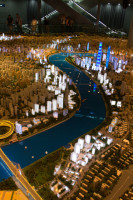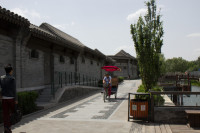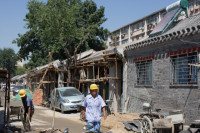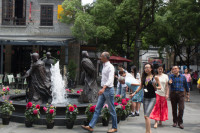Urban regeneration the Chinese way
It is probably fair to say that most British people’s perception of the Chinese economic miracle involves bullet trains, dozens of high rise apartments and skyscraper office blocks, motorway flyovers and prestige architectural projects ranging from new airports to the Beijing Olympics facilities. This is all true. Indeed seeing it all in person is a quite staggering experience. The Chinese people are rightly proud of it. Planning is a much revered profession in China. What other country has prestigious urban planning exhibition centres similar to those found in Beijing and Shanghai located right on the equivalents of Trafalgar Square? The permanent display in Shanghai includes significant acknowledgement of the British contribution over the decades, especially that of the Garden Cities and New Towns movement. What is less well known is the less glamorous but equally fascinating approach to urban regeneration. I will explore two approaches, one housing based in Beijing and the other cultural and retail-based examples in Shanghai.
What is less well known is the less glamorous but equally fascinating approach to urban regeneration. I will explore two approaches, one housing based in Beijing and the other cultural and retail-based examples in Shanghai.
‘Hutongs’ are the traditional residential neighbourhoods in cities. The term means ‘lane’ or ‘street’ and until the past 35 years a substantial proportion of ordinary Chinese people who lived in cities, lived in one. However as the population of every city have grown massively with migration and population growth, practically all the new residents have been accommodated in high rise developments and while many cities have expanded enormously into surrounding rural areas, the central and therefore most accessible and desirable areas, have been extensively redeveloped. Many of the hutongs have been swept away, characterised as areas with poor quality housing, poor facilities including lack of basic water and sanitation and inefficient in their use of space.
Despite this some the residents have resisted this trend as the alternative offered has often been a flat in a high rise blocks in a distant suburb away from friends, family and familiar neighbourhoods. Combined with a recognition on the part of the Communist Party of the value of historical and cultural traditions of which they now see themselves as the modern-day expression, a reclaimation of nationalism rather than its rejection under the Communism of the Mao era, and there has been a marked shift towards the preservation and renovation of traditional neighbourhoods and historic buildings.
At the time of the Revolution in 1949, there were about 25,000 hutongs in Beijing. Only about 800 remain in 25 ‘preserved areas’ with about 100,000 houses in all accommodating about 15% of Beijing’s population. Having spent several days walking the hutongs and being the guest of some local residents, it is easy to see why the hutongs are both appreciated and despised. They are mainly located in what are becoming the more desirable parts of Beijing – the Qianmen area of the city just south of Tiananmen Sq and the Forbidden City (and very close to the Museum of Urban Planning which overlooks Tiananmen Sq) and in the north of the city centre around the Shicha Lakes and their associated parks, which includes the newly-trendy Nanluogu Xiang district, an area that has become fashionable for high ranking cadres and successful entrepreneurs to live in. The Beijing end of the Grand Canal runs through this area and a number of new luxury housing estates have been built here in the in the ‘siheyuan’ or courtyard-style, modelled on hutongs and are very popular with foreigners too.
However traditional hutongs remain crowded, cramped, poorly maintained and with poor standards of plumbing and sanitation. One of the most striking aspects of walking around a hutong area is the density of public toilet provision , because practically no houses have their own. Besides having difficulty with providing them with proper plumbing, the houses are generally poorly constructed and very cold (and therefore energy hungry) in winter and being only single storey are an inefficient use of land in comparison to the high rise blocks nearby. In this context it is hardly surprising that traditional hutongs are under threat. But their historic significance is beginning to be understood and their attraction as an alternative to high rise living and as a way of retaining the historic cityscape, at least in parts of the central core of Beijing is being appreciated.  Throughout the Dashilan ‘preserved area’ about 15 minutes walk form Tiananmen Sq, there was extensive evidence of renovation work, with the whole side of a hutong being renovated at once in several parts of the area. Local people remark on the neighbourliness of hutongs and on my visit to Mr Mu and Mrs Wang’s home [see box 1] they were particularly appreciative of having lived in the house for so long with the same friends and neighbours around them and the proximity of the local markets just a couple of minutes from their door.
Throughout the Dashilan ‘preserved area’ about 15 minutes walk form Tiananmen Sq, there was extensive evidence of renovation work, with the whole side of a hutong being renovated at once in several parts of the area. Local people remark on the neighbourliness of hutongs and on my visit to Mr Mu and Mrs Wang’s home [see box 1] they were particularly appreciative of having lived in the house for so long with the same friends and neighbours around them and the proximity of the local markets just a couple of minutes from their door.
.
Box 1. Mr Mu and Mrs Wang.
Mr Mu and Mrs Wang live in a ‘’siheyuan’ or courtyard house in the Dashilan area south of Beijing city centre. There are 50,000 people living in this ‘preserved area’ in over 100 hutongs (lanes). The area has a Muslim tradition and their house was built around 1900 and was owned by an antiques dealer. It was nationalised by the Communist Government in 1949 and assigned to the Post Office for use by their employees. Mr Mu’s father a Post Office employee, was assigned it and he has lived there since childhood. The family has lived there since 1958 with two other families. Both are now retired, Mr Mu having worked as steel worker and Mrs Wang in the railway station. The house is rented from the Government and their rent is 80 yuan (£8) pcm. (a cup of coffee at a city centre Starbucks costs 40 yuan) Built round a courtyard, their part of the house has a living room, a second living room or bedroom, a bedroom, a small kitchen and a small bathroom. Although the structure is broadly similar to when they first moved in, it has been upgraded. Heating is now by electric heaters which were installed to replace coal fires to reduce city air pollution. Two thirds of their heating costs are covered by the Government, coal having been much cheaper than electricity. Water and sewerage were installed some years ago and the bathroom was created out of part of the kitchen. Cooking is on bottled gas. They keep a dog and turtles in the courtyard, along with plants and a place to hang out washing. There are electric fans in each room. Furniture is limited, a sofa, chairs, a grandfather clock and a TV in the living room. None of the rooms has direct sunlight. They all face onto a corridor which runs the length of the courtyard and is used to access all the rooms.
.
While Beijing is the political and administrative capital of China, Shanghai is its commercial and financial hub. This is reflected in its architecture including the completely new financial district, Pudong, which in 1990 was little more than some warehouses set amongst paddy fields and the world famous Bund constructed at the start of the last century which has undergone a major renovation after decades of neglect and is now an important tourist destination. Less high profile but reflecting the diverse architectural heritage of the city has been the arts, heritage and retail-led regeneration projects in the historic French Concession area to the west of the Bund such as Tianzifang and Xintiandi. Tianzifang has to a westerner a more distinctively ‘artsy’ feel, a mix of design studios, start-up boutiques wi-fi cafes and some original residents. Its three main north-south lanes are intersected by east-west alleyways giving an authentic ‘back streets’ feel to exploring the area. Anchor arts venues are the Deke Erh Arts Centre and the Beaugeste Gallery, which was hosting an exhibition entitled ‘A summer in Peking, 1978’ by Charles de Gaulle’s grandson Gregoire, which provided a graphic reminder of just how much things have changed.
Significantly closer to the city centre and the world of shopping malls and corporate HQ’s, Xintiandi is more interesting from a planning perspective because its location made it a more contested space. A fairly ordinary couple of blocks of reasonably good quality western-influenced Chinese middle class housing ‘Shikumen’ ( literally ‘stone gate’) , were developed in the early 20c in what would have been seen as a desirable part of the French Concession for bourgeois Chinese people to live in. It too had been neglected for decades. In 1996 proposals were brought forward for wholesale demolition and redevelopment. However this area had one unique feature. One of the shikumen was where the Chinese Communist Party was founded in 1921 and so has major importance in the history of the nation. It was something of a ‘eureka’ moment for the Chinese planning authorities as there was a realisation that historic and cultural assets had an economic value. The whole area has subsequently been redeveloped using the Museum of the National Congress of the Chinese Communist Party as the anchor tenant, by Honk Kong-based property development company Shui On Land and American architect Benjamin T Wood. Such has been its success that they have applied the same formula to a number of cities in China, including Wuhan and Chongquin and it has become a regular place of pilgrimage for Chinese planners seeking to understand the dynamics of successful urban regeneration – the ‘ Xiantiandi effect’ as it is known locally.  In reality almost all of the area has been demolished and rebuilt, not renovated, involving the removal of several thousand residents, retaining only the pattern of the lanes and the frontages of the shikumen with their distinctive doorways. The original houses would have been quite unsuitable for their current uses, upmarket restaurants, international coffee chains, boutique clothes shops and the like . The area is far too valuable to be retained for residential use. Apart from the Communist Party museum, just one shikumen has been retained as the Shikumen Open House Museum, which gives a good idea of early 20c Chinese gentility.
In reality almost all of the area has been demolished and rebuilt, not renovated, involving the removal of several thousand residents, retaining only the pattern of the lanes and the frontages of the shikumen with their distinctive doorways. The original houses would have been quite unsuitable for their current uses, upmarket restaurants, international coffee chains, boutique clothes shops and the like . The area is far too valuable to be retained for residential use. Apart from the Communist Party museum, just one shikumen has been retained as the Shikumen Open House Museum, which gives a good idea of early 20c Chinese gentility.
On the top floor of the museum is an exhibition of the history and process of the regeneration project, which admits that much of it is new. One rather revealing quote in the exhibition says; ‘Foreigners find it Chinese and Chinese find it foreign.’ The Xiangtiandi clientele reflected this, a high proportion of foreigners, very much in their ‘comfort zone’, with plenty of well-off Chinese people in a place to ‘be ‘seen’ in. The Communist Party museum itself studiously faces the other way onto the main street with no access from the tree-lined lanes with their outdoor cafes.
While the bulldozer remains king in Chinese cities, there is no doubt that urban regeneration is being taken more seriously as an option. It reflects the increasing confidence that the Chinese Government feels about its nations past and an increased desire to reclaim it, as well as an increasing willingness by foreign investors, led by companies such as Shui On Land, with its Chinese links, to invest in such projects. In the Five Year Plan adopted in 2011 the Central Committee announced that culture is ‘the spirit and soul of the nation’ and would become a ‘pillar industry’ representing 5% of GDP. The kinds of preservation and regeneration projects described are very much in that spirit.
This article appears in the December 2014 issue of Town and Country Planning

